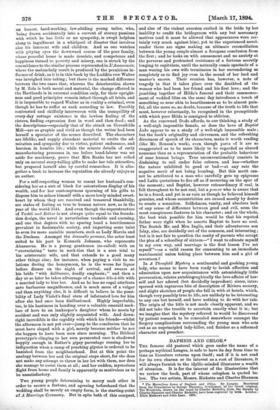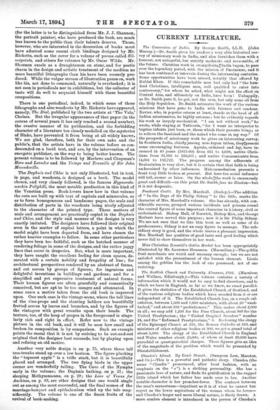DAPHNIS AND CHLOE.* THE famous old pastoral which goes under
the name of a perhaps mythical Longus, is safe to have its day from time to time as literature returns upon itself ; and if it is not read for its own charms or its interest as a root of literature, it will always furnish to the idyllic-minded illustrator a wealth of situation. It is for the interest of the illustrations that we review the book, part of whose colophon is quoted be- low. The two artists, Messrs. Ricketts and Charles Shannon
• The Marvellous Loves of Daphnis and Chloe. By Longue. Reprinted from the Translation by George Thornley, Gentleman, of the Greek original. The Woodcuts, drawn on the wood by Charles Ricketts, from the designs by Charles Shannon and Charles Ricketts, have been engraved by both. London : Elkin Mathews and John Lane. 1883. (for the latter is to be distinguished from Mr. J. J. Shannon, the portrait painter), who have produced the book, are much less known to the public than their talents deserve. Those, however, who are interested in the decoration of books must have admired some recent cloth bindings designed by Mr. Ricketts, such as the cover for a volume of poems called SU- verpoints, and others for volumes by Mr. Oscar Wilde. Mr. Shannon excels as a draughtsman on stone, and for poetic charm in the design and artistic treatment of the medium no more beautiful lithographs than his have been recently pro- duced. While the vulgar stream of illustration pours on, work like his, not done to command, naturally is overlooked ; it is not seen in periodicals nor in exhibitions, but the collector of taste will do well to acquaint himself with these beautiful compositions.
There is one periodical, indeed, in which some of these lithographs and also woodcuts by Mr. Ricketts have appeared, namely, The Dial, published by the two artists at The Vale,' Chelsea. But the irregular appearances of that paper (in the course of several years it has only reached a second number), the evasive manner of its publication, and the forbidding character of a literature too closely modelled on the mysteries of Blake, have prevented it from being at all widely known. We are glad, therefore, both for their own sake and the public's, that the artists have in the volume before us con- descended on a lucid text, and are, by the intervention of an energetic publisher, on the way to being better known. The present volume is to be followed by Marlowe and Chapman's Hero and Leander and the Voiage and Travaille of Sir John Maundeville.
The Daphnis and Chloe is not only illustrated, but in text, in page, and woodcuts, is designed as a book. The model chosen, and very closely followed, is the famous Hypneroto- machia Poliphili, the most notable production in this kind of the Venetian press. Book-lovers know how in that volume the cuts are built up with text of capitals and minuscules, so as to form homogeneous and handsome pages, the scale and distribution of parts in the woodcuts being nicely adjusted to the character of the printed type. These matters of scale and arrangement are practically copied in the Daphnis and Chloe, and the style and manner of the designs is very exactly imitated. The designers have followed their original even in the matter of capital letters, a point in which the model might have been departed from, and have chosen the rather heavier examples to follow. In some other particulars they have been too faithful, such as the hatched manner of rendering foliage in some of the designs, and the rather jaggy lines that occur in draperies. But, what is more important, they have caught the excellent feeling for clean spaces, de- corated with a certain nobility and frugality of line ; for architectural perspectives rendered by an abstract of forms, and cut across by groups of figures; for ingenious and delightful inventions in buildings and gardens; and for a simplified and yet expressive treatment of natural forms. Their human figures are often gracefully and romantically conceived, but are apt to be too meagre and attenuated. In some cases a motive taken from the old book is improved upon. One such case is the vintage scene, where the tall lines of the vine-props and the slanting ladders are beautifully fretted across by leaves and branches, and by the figures of the vintagers with great wreaths upon their heads. The texture, too, of the heap of grapes in the foreground is singu- larly rich and right in effect. Refer now to the vintage picture in the old book, and it will be seen how small and broken its composition is by comparison. Such an example points the moral that it is not by striving to be out-and-out original that the designer best succeeds, but by playing upon and refining an old motive.
Another very noble design is on p. 75, where three tall tree-trunks stand up over a low horizon. The figure plucking the "topmost apple" is a trifle stark, but it is beautifully placed and arranged. The two flying birds in the upper corner are wonderfully telling. The Cave of the Nymphs early in the volume; the Daphnis bathing, on p. 21; the sleeping Methymnaeans, on p. 29 ; the Love of Venus for Anchises, on p. 83, are other designs that one would single out as among the most successful, and the final scenes of the marriage-banquet and epithalamium wind up the tale mag- nificently. The volume is one of the finest fruits of the revival of book-making.



































 Previous page
Previous page